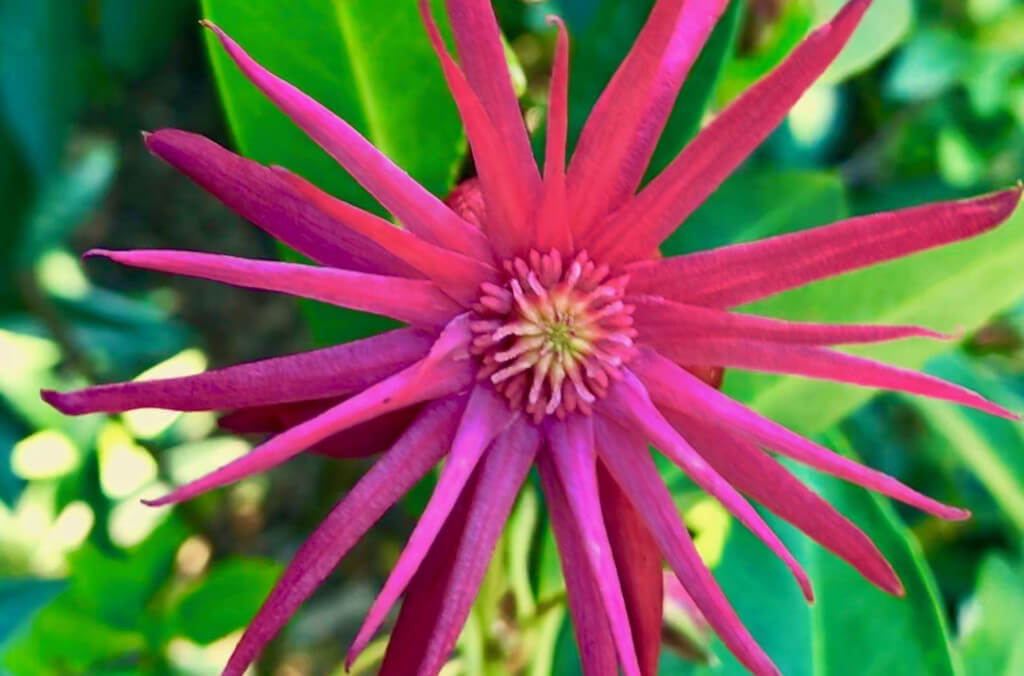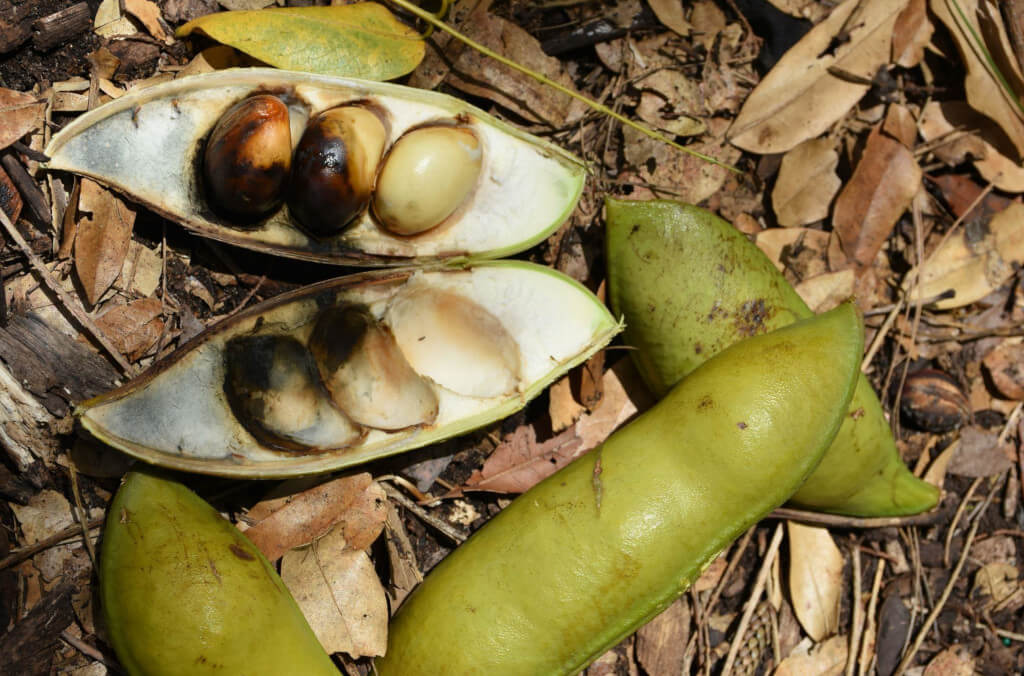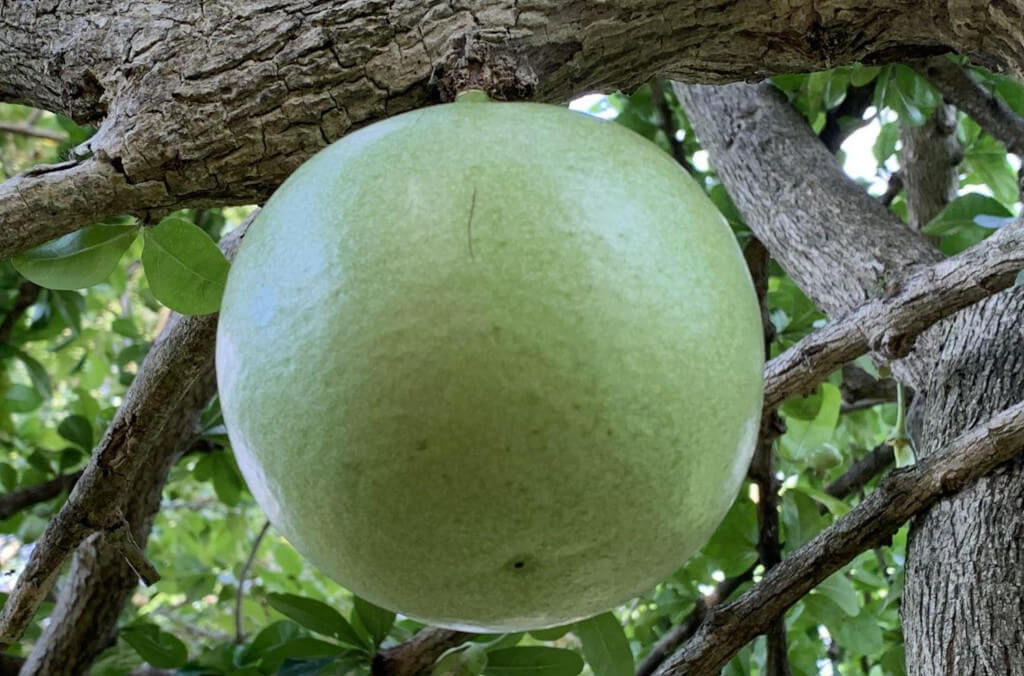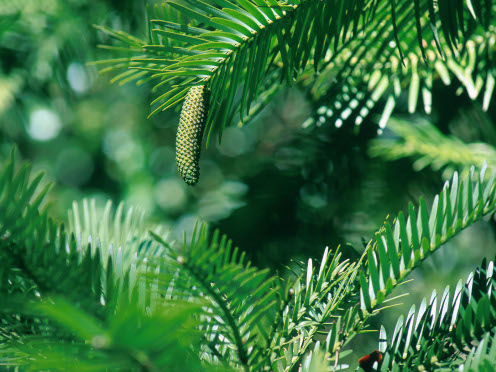Discover this month's Autumn Blooms
As the weather slowly cools we watch the transformation of the fabulous flowers of summer to the funky seed-bearing fruit of autumn.
Chamal
Dioon edule
This cycad is endemic to north-eastern Mexico. It grows in rocky areas with shallow soils which are subject to drought and frequent bushfires. It is a slow growing, medium sized cycad with an erect trunk and a rigid crown of light green leaves. Like all cycads it produces male and female cones on separate plants. Wild plant are threatened by illegal collection, prolonged drought, bushfire and habitat destruction.
Family: Zamiaceae
Purple Anise
Illicium floridanum
Native to swamps in southern states of the USA and the montane forests of northern Mexico, this shrub likes shade and moisture. The unusual dark red flowers give off a fishy smell that attracts small flies who carry out pollination. The crushed leaves give off a pleasant smell similar to anise. Although no part of this plant is edible, it is a close relative of the spice star anise (Illicum verum) from China and Vietnam.
Family: Schisandraceae

Portea petropolitana var. extensa
This stunning plant is one of nine species in the genus Portea which originates from the Atlantic coast of Brazil. A terrestrial bromeliad, it grows on rocks and in sandy soil in its native habitat. The flower spike with its many branches covered in purple flowers emerges above the rosette of spiny, lime green leaves. Attractive but inedible dark purple fruit follow flowering.. After producing seed, the rosette of leaves die. Offsets call at the base of the plant, called pups continue to grow and flower.
Family: Bromeliaceae
Black Bean
Castanospermum australe
Look out for the large seed pods that can be seen hanging from the branches of this Australian rainforest tree ready to drop. The large pods contain three to five chestnut like seeds which are toxic. Aboriginal cultural groups developed methods to neutralise these toxins and create an edible flour. Our scientists working with Aboriginal knowledge custodians have shown that seeds were planted thousands of years ago by people along pathways known as Songlines.
Family: Fabaceae

Klinky Pine
Araucaria hunsteinii
This tree from New Guinea can reach 90 m in height, making it one of the tallest tropical trees in the world. Our trees are still relatively young but have started to produce impressive female cones. Look high into the canopy and you may see oval, dark green female cones at the ends of branches. Male cones bear the pollen and are a slender finger-like shape. The common name comes from the sound of the wind blowing through the partially peeled outer layer of bark.
Family: Araucariaceae
Queen Protea hybrid
Protea magnifica x prudens ‘Juliet’
Proteas are native to South Africa and commonly called sugarbushes. The flowers are long and tubular clustered in the centre and surrounded by colourful bracts creating a long lasting inflorescence in varying shades of pink, red, cream, white and yellow. Protea magnifica, or Queen Protea, has the second largest flowers of the genus, while Protea prudens is a low growing ground cover. Their hybridisation has produced a rockery plant with stunning flowers.
Family: Proteaceae
Wonderful Calabash
Crescentia mirabilis
Crescentia mirabilis is endemic to the northern coast of Cuba. Crescentia species are collectively known as Calabash for their large woody fruits that resemble woody gourds. It is easy to miss the trumpet-like flowers that appear in spring as they are borne on the trunk and branches. The large woody fruits are obvious at this time of year and while they are not edible, the shells are used for containers and musical instruments.
Family: Bignoniaceae

Milky Sap Tree
Tabernaemontana littoralis
Native to Central America, this small evergreen tree from the Frangipani family, is suitable for small garden spaces. Its bright white flowers have a musky sweet fragrance that is stronger at night. The lower part of the corolla tube is pale yellow. Like other members of this genus, leaves and stems exude a milky sap when damaged. This sap is toxic and is irritating to the skin and especially the eyes.
Family: Apocynaceae
Explore the Garden this month
Our guided walks are the perfect way to experience the very best of the Garden.

This month's tour features rare and resilient plants that have survived for millennia.

Botanical art is putting the impacts of climate change on plants in the spotlight following the opening of The Garden Gallery and new labs for the Research Centre for Ecosystem Resilience (ReCER) at the Royal Botanic Garden Sydney.
Tropical gems and temperate favourites feature on this month's tour.